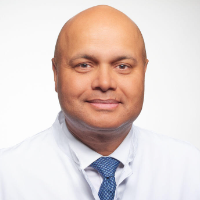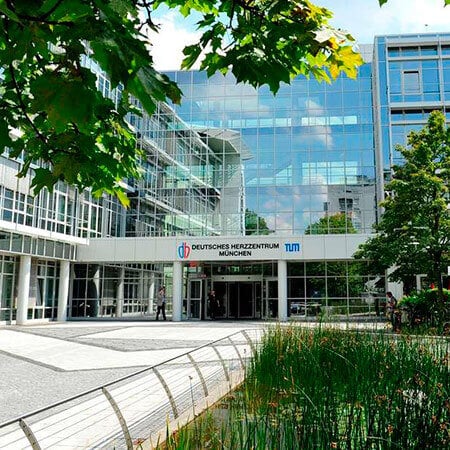Annuloplasty With Mitralign System for Mitral Valve Insufficiency (prolapse) in Germany
Treatment prices are regulated by national law of the corresponding countries, but can also include additional hospital coefficients. In order to receive the individual cost calculation, please send us the request and medical records.

Department of Cardiac Surgery
The Department of Cardiac Surgery offers the full range of surgical treatment for heart disease, with the exception of chest organ transplants. The medical facility successfully performs operations for mitral, aortic, and tricuspid valve replacement and repair, operations for the implantation of pacemakers, implantable cardioverter-defibrillators, and devices for cardiac resynchronization therapy, operations for thoracic aortic aneurysms and dissection, coronary artery bypass grafting, and operations for the implantation of ventricular assist devices and artificial hearts (VAD and TAH). Most surgical procedures are performed using minimally invasive techniques without opening the chest. The department is part of the Heart Center Siegburg, where cardiac surgeons, cardiologists, and vascular surgeons work together for the benefit of patients. Complex clinical cases are considered by medical boards. This allows physicians to develop the most effective course of treatment for each patient. The Heart Center Siegburg treats over 7,000 patients annually, many of whom undergo cardiac surgery. Along with the use of the latest technologies and treatment methods, the department's cardiac surgeons attach importance to a humane attitude towards patients.


Department of Cardiac Surgery
The Department of Cardiac Surgery offers the full range of modern surgical treatments for cardiovascular diseases. The department enjoys a reputation as a leading medical facility specializing in treating acquired heart defects. The department's surgeons perform about 2,800 cardiac surgical interventions every year, including especially complex ones. Cardiac surgeons most often perform operations for heart defects and pathologies of the coronary arteries, heart valves, and aorta. All operations are performed in state-of-the-art operating rooms with advanced equipment and high-precision monitoring systems, which make surgical treatment not only the most effective but also the safest for a patient. Sparing, minimally invasive techniques are widely used in clinical practice, and some operations are performed without the use of a heart-lung machine. After the operation, the patient receives proper care for a rapid recovery.

Mitral valve insufficiency is the second most common acquired heart disease after aortic stenosis. The disease affects approximately 2% of the world's population. Open surgery is usually performed to treat mitral defects. In the secondary form of the disease caused by the mitral annulus enlargement, the surgical method is, however, too risky for patients because many of them suffer from heart failure. In such cases, minimally invasive endovascular repairs are performed. One of the methods is the implantation of the Mitralign system. The technique is available in Germany and other developed countries. You can go abroad for treatment with this method. You are welcome to visit the Booking Health website to find out the cost of treatment in Germany and make an appointment for your Mitralign implantation at the best price.
Content
- What is mitral valve insufficiency?
- Who may be a candidate for a Mitralign mitral valve annuloplasty?
- How is the procedure for mitral valve insufficiency performed?
- Results of an annuloplasty for mitral valve insufficiency
- Why to undergo your mitral valve insufficiency treatment in Germany?
What is mitral valve insufficiency?
The mitral valve is located on the left side of the heart. It closes the passage from the atrium to the ventricle. Thanks to the valve, the blood flows only in one direction and does not return. To do this, the valve must close the hole between the atrium and the ventricle completely. However, due to damage to the valve apparatus and, more often than not, due to the mitral annulus enlargement, it cannot be closed. This is how regurgitation develops: more and more blood flows in the opposite direction, overloading the left atrium and gradually increasing the left chambers of the heart.
The following conditions may cause mitral valve annulus enlargement:
- cardiac ischemia;
- dilated cardiomyopathy;
- hypertrophic cardiomyopathy;
- myocardial infarction with papillary muscle necrosis;
- left atrial enlargement due to chronic atrial fibrillation.
For a long time, any symptoms of the disease are evident. In addition, since damage to the mitral valve occurs secondarily due to other cardiac pathologies, they mask the symptoms of mitral regurgitation. In the advanced stages, patients suffer from:
- fatigue;
- shortness of breath that appears or worsens with exertion;
- difficulty breathing when lying down;
- nocturnal shortness of breath;
- increased pulse pressure (big difference between systolic and diastolic pressure);
- leg swelling;
- fainting;
- accumulation of fluid in the abdominal cavity;
- liver enlargement.
The main method of diagnosing the disease is echocardiography. Cardiac catheterization and MRI are less commonly used.
Treatment of mitral regurgitation is required when the diameter of the mitral annulus increases to 4 cm or more, along with a deterioration in left ventricular function and enlargement (final diastolic volume greater than 4.5 cm).
Who may be a candidate for a Mitralign mitral valve annuloplasty?
The system is used to treat mitral valve insufficiency (mitral valve prolapse). It can be primary or secondary. The primary type of the defect is characterized by the valve itself being damaged, while the secondary type of mitral valve insufficiency causes the enlargement of the mitral valve opening. As a result, even normal leaflets are not able to completely block the blood flow in the opposite direction.
The goal of mitral regurgitation treatment is to reduce the diameter of the valve annulus and the area of the valve orifice. The main method of repairing the valve is open heart surgery. However, almost half of the patients belong to the high surgical risk group. They are more likely to have complications due to heart conditions or other diseases. For such patients with mitral regurgitation, an alternative treatment option in Germany is a minimally invasive Mitralign annuloplasty.
The transcatheter procedure is performed through the femoral vessels, which are approached in the groin area. Patients do not require any traumatic intervention or general anesthesia, so the treatment can be tolerated even by elderly people with poor health.
How is the procedure for mitral valve insufficiency performed?
The Mitralign system is a set of catheters and guidewires used for a direct annuloplasty. The goal is to narrow the annulus so that the valve can close it and prevent blood from returning to the left atrium.
A 13.5 F delivery catheter is inserted retrogradely through the ventricle and aortic valve. This is positioned on the posterior surface of the left ventricle of the heart. With the help of radiofrequency ablation, a guidewire penetrates through the fibrous ring into the left ventricle. A catheter is then delivered through it to reduce the fibrous ring.
Inside the heart, the patch is opened and placed on both sides of the mitral valve annulus. The second patch is delivered in the same way as the first. They are pulled together and closed using a medical steel mechanism.
Doctors then use a second pair of patches. It is placed on the opposite side. Two pairs are pulled together, thereby reducing the mitral valve area.
The procedure is safe and minimally traumatic. The catheter is delivered to the heart through the femoral artery. The procedure is performed under angiographic guidance. The position of the system in the heart is monitored using real-time transesophageal echocardiography.
Results of an annuloplasty for mitral valve insufficiency
The result of a mitral valve annuloplasty is a reduced annulus size of an average of 20 mm. The area of the mitral valve also decreases.
As a result, patients recover normal hemodynamics. It is possible to eliminate mitral valve insufficiency or reduce the severity of mitral valve regurgitation. Following valve repair, the risk of developing heart failure is reduced. Patients have a potentially increased life expectancy.
The quality of life improves almost immediately after the mitral valve repair. Patients are better able to tolerate physical activity and do not suffer from symptoms of heart disease, or the clinical manifestations are minimal and have minor effects on daily activities.
The benefits of the Mitralign annuloplasty for valve prolapse are the following:
- the procedure can be performed on patients in the high surgical risk group for whom surgery is contraindicated;
- minimal trauma rates;
- no need for general anesthesia;
- an easy postoperative period;
- a rapid recovery of patients;
- a minimal period of hospitalization.
Why to undergo your mitral valve insufficiency treatment in Germany?
The Mitralign system is not yet widespread in the world. It is not yet used in many countries. The Mitralign may also not be available for mitral valve repair in your country. In this case, you can undergo your treatment in Germany. Mitral valve prolapse is treated at German hospitals not only with open surgery but also using minimally invasive techniques through the blood vessels.
Treatment in Germany has the following benefits:
- German hospitals have state-of-the-art equipment;
- doctors in Germany have vast experience in minimally invasive treatment of mitral valve defects, including with the help of the Mitralign system;
- the procedure has a minimal risk of complications, even in elderly and debilitated patients;
- in the vast majority of cases, the Mitralign system is implanted successfully, with the achievement of all the goals of the procedure;
- an affordable cost of treatment in Germany as compared with other countries offering advanced medicine;
- patients are treated in comfortable conditions and receive high-quality care at German hospitals.
You are welcome to use the Booking Health service to find out the cost of treatment in Germany and compare prices at different German hospitals. When you make an appointment through Booking Health, the cost of treatment in Germany will be lower for you than if you contact a German hospital directly. The price is reduced due to the absence of additional taxes for foreign patients. After the start of the medical care program, the cost of treatment in Germany will not increase because you will receive insurance that will cover unforeseen medical expenses.
The medical tourism agency Booking Health will organize your treatment in Germany. We will contact the hospital administration, make an appointment for your preferred dates, help you reduce the waiting time for the start of your treatment in Germany, and translate your medical documents into German. We will also book the nearest hotel to the hospital for you and buy airline tickets. Our company's specialists will meet you at the German airport and take you to the hospital by car. After the completion of your treatment in Germany, they will take you back to the airport.
Authors:
The article was edited by medical experts, board-certified doctors Dr. Nadezhda Ivanisova and Dr. Vadim Zhiliuk. For the treatment of the conditions referred to in the article, you must consult a doctor; the information in the article is not intended for self-medication!
Sources:
European Society of Cardiology

